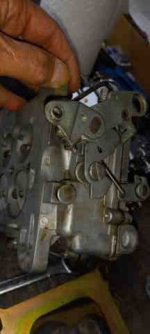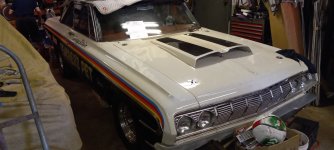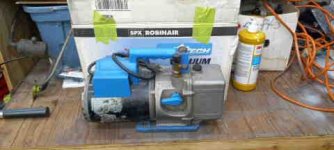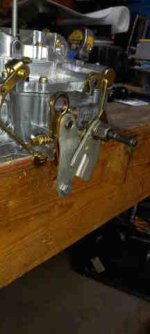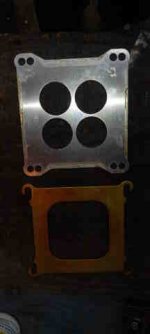Here we go, first one I think I don't need to ask but just to be safe................... they say I MUST use a fuel line adaptor kit to convert my metal line to a hose?
Pretty sure since it worked on the other carb, my adaptor fitting overrides that??????
If it worked on the old one and didn't leak, I can't see any reason not to use it on the new one.
Next on thermo quad & quadrajet carbs you need their 4 round hole adaptor says not to use a square bore.
edelbrock # 2696 in the pic it looks pretty thick.
You definitely don't want the 4-hole flat plate, nor do you want two plates. Two plates is essentially begging for a vacuum leak (there would be three gaskets, hence six potential leak spots). The Edelbrock part would be ideal, with Mr Gasket 1932 being a reasonable second place (and you probably know someone local that's got one hanging on a nail in their garage). If the open plate you were using previously cleared all four throttle blades, it's probably OK--but you should double-check. The AVS2 may have larger rear bores, which could hit the plate you were using.
The Mr Gasket is less expensive, while Edelbrock will drive more nicely due to its 4-hole design. I won't bore you with the physics of it, but the 4 small holes will maintain charge velocity better than one big opening. That's better for around-town driving. Yes, it's noticeable.
The downside to the Edelbrock and Mr Gasket adapters is that they're fairly thick--a little over 3/4" in either case. I don't believe you'll have hood issues, but it can affect things like throttle cable reach, kickdown linkage, and possibly the fuel line. Ever see the super-high-rise throttle-cable bracket I have on Agnes? The Slant Six throttle cable was the only one that would reach!
Whichever way you go, make sure your chosen plate sits absolutely flat to both the intake and carb before you try to install anything. If it's warped, it will
not "flatten out" sufficiently when installing the carb.
Do I have timed advance or full advance timed would be passenger side port full would be drivers side?
Factory was "timed", more correctly called ported. I'd stick with that. It works well and is a
lot less f__kin' around to get right. On Agnes I was using full, but that's a completely different beast.
Correct. Fully up to operating temperature, gauge where it would normally be during driving. Messing with anything prior to that is spitting into the wind, trust me. It's also true of all the following calibrations.
3 more adjustments I'm not too sure about after it's running
calibrate the pump
Maybe. That's one of those "you have to drive it" things.
Start with the out-of-the-box setting and drive it around a bit. See if it's OK on "jackrabbit" starts from a stop--not necessarily drag-race, full-throttle starts, more like "I don't think that goon is slowing down enough behind me" starts. Find a lonely stretch of road with enough speed limit, and travel at 25-30MPH constant speed. Now push it quickly to half-throttle (or more). Finally, when you get a chance, just floor it from a standing start. If it stumbles on rapid throttle input, generally you need
more accelerator pump shot. There are three holes in the accelerator-pump arm; the rod should be in the middle one out of the box. The first thing to try is moving the rod that moves the pump arm closer to the fulcrum (pivot point). If it gets worse, move it to the furthest position.
Honestly, I think this is going to be OK out of the box
if we get the mixture screws tuned correctly. If we can't make those do their thing, well, you'll need a ton of pump shot (closest hole, larger squirters) to cover the stumble.
This is pretty easy to do if it's required. Again, this is more of a "drive it and see" proposition.
The air doors (a.k.a. "air valves") regulate how quickly the secondaries operate by restricting through them airflow. When you drive the car, you need to floor it (in a safe space) just long enough to get the doors to open, a.k.a. "kick in the four-barrel". If it reacts instantly, like it should, don't mess with them. If it stumbles or "bogs", believe it or not, that usually means they're not opening quickly enough. Follow the calibration procedure (I'm sure the instructions give an idea of how big a step to take in this process) until standing on it provides instantaneous "
OH-I'M-IN-TROUBLE-NOW" acceleration. No hesitation, no bog, just RIGHT NOW power.
Factory carburetors with secondary air valves or doors were notoriously set up with the doors too tight. That resulted in a hesitation when opening the secondaries that gave us the derogatory terms "ThermoBog" and "Bog-drajet" or "Quadra-Bog". Both the ThermoQuad and QuadraJet are actually
fantastic carburetors, particularly on street-driven cars... people just aren't aware that the hesitation is easily tuned out of the equation.
float adjustment, I assume the last should be factory set?
This should actually be the first thing you do, since idle mixture
can be affected by fuel level in the bowl. I won't bore you with those physics either, but it has to do with pressure across the mixture screws' orifices. It should be factory set, and the instructions should mention whether it is. Then again, a lot of things
should be and
aren't.
I think on that carb the float adjustment requires disassembly (that's how most Carter designs work). I would also think a brand-new $450 carb would have the float level correctly set right out of the box, but Holleys rarely do. Then again, Holley floats are externally adjustable in most cases. Anyhow, if nothing else, call Edelbrock's tech line--you paid for it--and get the full skinny from a human.
Despite having my fingers in dozens of carbs over the years, I wouldn't want to have to disassemble a brand-new one for something the factory
should've done. Find out.


